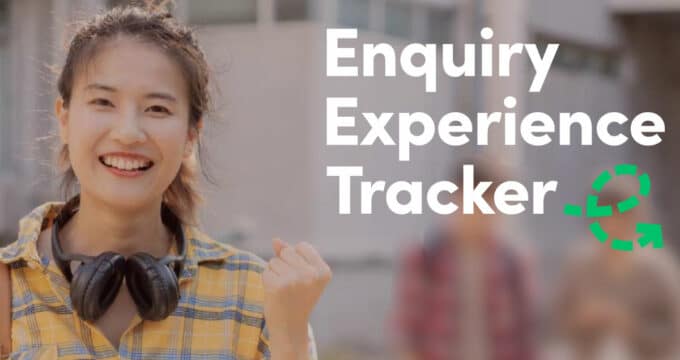University websites: How can we make them better for international student recruitment?
The following is a guest post by Guus Goorts, and is excerpted with permission from his forthcoming book, Genuinely helpful: A practical guide to effective university websites. Guus is a Netherlands-based author, digital marketing specialist, and online marketing trainer specialising in the higher education sector.
I know plenty of examples where an organisation got tired of their existing, ugly website and replaced it with a better-looking one – and ended up with worse performance: lower engagement, fewer conversions or less search traffic compared to their old site. It has happened to me, too.
If a website has been around for a while, some portions will probably do their job brilliantly, even if everyone feels they look outdated. So before you make significant changes to your existing website or start designing a new one, make a plan. While nothing in life goes entirely according to plan, knowing where you’re heading will help you stay on course.
When you have a solid plan, it will also become easier to say ‘no’ to ad hoc requests from across the institution – you can simply explain that they would take the website off track (and why).
Fortunately, there are proven methodologies to help you improve your website. To be clear: when I say ‘improve’, I don’t necessarily mean redoing everything. Sure, there are times when it is best to start from scratch, but that isn’t always feasible immediately. The good news is, you can usually achieve a lot just by changing text and images and perhaps adding and removing a few pages.
In this book, we will use SEO as the main framework for website planning and design because it encompasses much of what people do on your website, from discovering your website in the first place to navigation and engagement.
But there are many other methodologies that partially overlap with SEO and have valuable perspectives to add. You’ll likely already be familiar with many of them. While I won’t cover all of them in depth, it is helpful to introduce the most important ones here. That way, you’ll know what expertise is available and how the different approaches can support each other.
Student journey
I don’t like the phrase ‘student journey’ – it sounds very much like bullshit to anyone who isn’t familiar with the concept. For any non-marketers in the room, consider replacing it with a phrase like ‘communicating consistently with students across organisation units’.
But semantics aside, the student journey is an important lens for looking at your website (though the concept encompasses much more than that) and it’s supported by a community of experts and documented best practices. This phrase uses the metaphor of a journey that the student makes, from deciding where to study, to applying and onboarding, to being a regular student, and then to graduating and maybe becoming part of the alumni association.
Different departments are responsible for specific portions of this journey and things often don’t work smoothly when responsibility for the student passes from one team to another.
Students remain the same person along the journey, though, and regard your institution as a single entity. They don’t care if the message comes from marketing or the registrar’s office, they just want an answer – and they don’t want to be asked for the same information repeatedly.
Student journey mapping is a way of graphically representing all the interactions a (prospective) student will have with your institution. By bringing groups representing different departments together, you can identify the gaps and points of friction and adjust processes to make the journey smoother for students. Called the ‘customer journey’ in the business world, ‘journey mapping’ can be applied to any audience an organisation serves, whether it’s students, staff, external scientists or another group. It just so happens that for most universities, students take priority: they’re the largest group and have the most complex needs.
How does the student journey relate to marketing and building better websites? Web content is a very effective way to support students on their journey. During the stages of their journey, students will visit different webpages and other content to find out what to do. When they search in Google, they will use different keywords depending on the stage they are at. By making sure the right content is available and easy to find on your website every step of the way, you can take away a lot of guesswork and uncertainty on the part of students and save yourself from repeatedly answering the same questions.
For example, NHL Stenden’s English homepage has information about all stages of the student journey available year-round, but highlights different content in the top section depending on the time of the year. In February, it emphasises open days and webinars, while in June, the homepage starts with a huge banner that advertises their housing guarantee. You can read more about how they did this and how they plan to take things even further in the NHL Stenden case study (Chapter 12).
If you get a knot in your stomach when you hear the words ‘student journey’, you’re not alone. At an organisational level, student journey mapping is a complex and protracted process which can be rife with conflicts. Don’t worry about the organisational process here, and certainly don’t wait to apply the student journey lens to your website with what you know today.
Wherever your institution is in the organisational student journey mapping process right now, as a marketer you can ensure that the content on your website supports (prospective) students during each step of their journey. Even if it’s not perfect right away, get going and you can always come back to the content and fine-tune it later. In Chapter 4, we will discuss planning and creating relevant website content. The stage of the student journey reached by the prospective student is one of the key factors to consider.
Is your website accessible?
Here’s another lens for viewing your website: is it accessible to as many people as possible? An inclusive and diverse institution should be easy to interact with, even if a website visitor has a visual, auditory, motor, speech or cognitive impairment. For example, people with visual impairments may use screen readers that read out the website text to them. Screen readers only work well when website content is clearly structured with descriptive page titles and helpful headings. If you miss this structure, the website may look no different to a non-impaired visitor but will become much harder to use for someone who relies on a screen reader.
Compliance with accessibility standards is often mandated by law. Public institutions are often held to higher standards. The most common framework for implementing accessibility is the Web Content Accessibility Guidelines (WCAG).
Accessibility isn’t only about the technical setup, design and structure of your website: the content matters, too. The question any wheelchair user will have when they are about to visit a building is, ‘Will I be able to get around in my wheelchair?’
As a marketer, you’re not in charge of building wheelchair ramps, but even if your building has serious accessibility issues, having a clear accessibility page signposted in your menu can make things much more straightforward. Provide advice on which entrance to use and who to contact for support – and you’ll take a lot of guesswork out of the visit.
Good accessibility practice fits well with SEO best practices, but there are additional things to keep in mind. I will cover accessibility in more depth in Chapter 6.
Conversion rate optimisation (CRO)
While it’s great if your website is helpful, just having the world’s most helpful university website will not get you far. At a certain point, your website also needs to lead visitors to their next action, such as:
• Initiating a chat with a student ambassador
• Filling in an enquiry form
• Signing up for a newsletter
• Getting started with an application
Each of these actions can be referred to as conversions. The percentage of website visits that includes a conversion is the conversion rate.
Conversion rates vary greatly between websites and they can make all the difference. Imagine that two websites both get 2000 visits in a day. If the first website has a 5% conversion rate, while the conversion rate of the second is 10%, it could mean the difference between 100 and 200 email addresses captured daily on your website. If all your marketing activities together are a football team and the website is the star striker, can you imagine how much of a difference it makes when your striker is twice as likely to score when they get the ball?
Achieving a good conversion rate overlaps with all the other approaches: relevant, discoverable and accessible website content builds trust and confidence to set your audience up for further engagement. Beyond all the above, there are specific things you can do on your site to encourage people to take action. For example, CRO best practice asks for clear calls to action (CTAs) on your website to encourage people to take the next step.
A specific CRO-related pitfall in higher education is to scatter prominent ‘apply’ buttons across the website. Since applying entails a lot of work for prospective students, it’s not something they can do quickly. That’s why prospective students usually leave a site if they get asked to apply too soon unless they are sufficiently motivated. It’s better to emphasise smaller steps, such as ‘chat with a current student’ or ‘register for a webinar’, as your key CTA. These deeper interactions will build the confidence that your institution is worth the effort of applying.
Web analytics
Simply putting all of the above approaches to work is no guarantee of success. You may believe your website is perfectly optimised – it looks beautiful, and its content is relevant and inspires action.
But just like in a football game, it’s not about which star players are on your team. Ultimately, it is the scoreboard that counts. Web analytics is what you can use to keep score. Popular software for web analytics includes Google Analytics 4, Matomo and Piwik PRO.
In football, the main thing you want to keep track of is the number of goals. But there are many other things you can track which will give you an insight into what is already working and what needs improvement, such as shots on goal, fouls and ball possession.
In analytics, the ultimate goal on the student front would be enrolments. Steps along the way that you’ll also want to track include website visits, number of pageviews, open day registrations and so on. By keeping score, you can pinpoint bottlenecks and focus your efforts on alleviating them. For example, it won’t do you much good to focus on improving a website’s conversion rate if barely any prospective students visit your website.
Another important role for web analytics is to share performance with internal stakeholders. This can help everyone get on board and stay engaged with improving the website experience. I will cover analytics and communicating results in Chapter 11.
Search engine optimisation (SEO)
I started off the previous chapter by likening your website to a party. The previous approaches were all about making sure the people at the party have a great time. But before you can have a party, you need a crowd. Without enough people, it’s not a party. You also need the right mix of people.
SEO is concerned with attracting the right profile of people to your website. The kind of people you want to draw close to your institution. That includes prospective students who fit your ideal profile but there are other people you would want to attract, too.
For example, a city official who is thinking of revitalising and greening a neighbourhood may discover the work of your architecture faculty. Or a scientist at another institution might discover a project at one of your faculties that’s closely related to a study they are working on.
While you could (and probably should) advertise your programmes and projects, doing so requires constant effort and expenditure. The SEO framework is all about putting in the foundational work to make sure your website gets discovered by as many of the people you want to be at your ‘party’ as possible – when they are looking for answers, and not only when you get around to promoting yourself.
Most universities never get around to strategically using SEO, which is a giant missed opportunity – and it’s also one of the main reasons I wrote this book. As you can read in its case study (Chapter 15), the University of Rochester managed to get the same content viewed ten to twenty times more by optimising it for search engine discovery. SEO has amplified everything these pages were previously doing by a factor of ten!
That’s why SEO is the main focus of this book. SEO is the method for making sure your intended audience finds your well-crafted content listed prominently in the search engines, right at the moment when they need it most: when they search for it.
Conclusion: Approaches for improving your website
In this chapter, I have briefly introduced the key approaches that you can use to improve your website. They all overlap to some extent, but each provides a slightly different angle. To keep this book manageable, we’ll look at your website mainly from the angle of SEO, but I will also bring other approaches into the discussion where they have something important to add.
For additional information, please see:
















